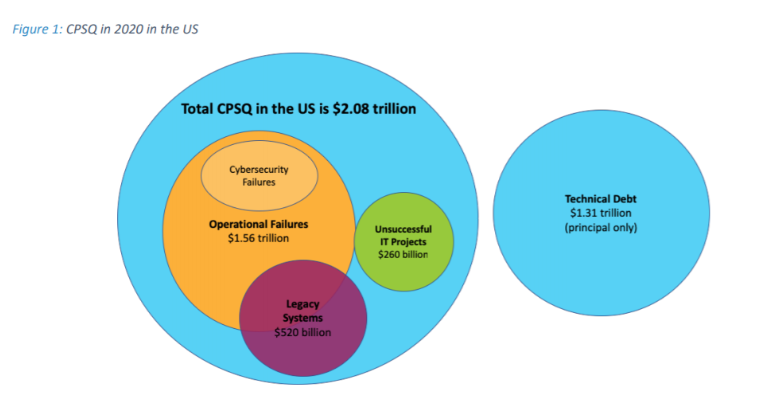A report released by the Information and Software Quality Alliance (CISQ) pointed out that affected by the epidemic, many companies and organizations have begun to vigorously move towards digital transformation in 2020. In this context, software-based innovation and development are also rapidly expanding. However, while the quantity of software has achieved rapid growth, its quality has not been guaranteed. The quality of some software lags far behind the standard, causing additional burdens and financial losses to the companies that use it.
In 2020, the United States has paid a cost of 2.08 trillion U.S. dollars due to poor software quality. In addition, the report also pointed out that if the serious defects in the software technical debt of the United States in 2020 are to be repaired, it will cost 1.31 trillion US dollars (not including interest). This also means that the cost will increase in the future. Since 2018, it has risen by 14%.

Data shows that in 2020, unsuccessful IT projects alone will cost US companies US$260 billion, while software problems in legacy systems will cost companies US$520 billion, and software failures in operating systems will cost companies’ finances. Revenue leaves a gap of US$1.56 trillion.
CISQ said that compared with the US$1.4 trillion in IT and software wages, the figure of US$2.08 trillion "highlights the negative impact of poor software quality on the economy." Bill Curtis, executive director of CISQ, said that in the United States alone, the losses caused by operational failures are staggering. It only takes a major failure or security breach to offset the value that the company gains by speeding up time to market. Therefore, when the potential loss reaches this scale, rigorous software engineering becomes very important.
The report shows that although the cost of traditional IT headaches has fallen from US$635 billion two years ago, the losses caused by failed projects and software errors to the company have increased significantly over 2018, with US$1.775 billion and US$1.275 trillion respectively. .
According to CISQ, in addition to the failure to balance the development relationship between speed and quality; the reason why the cost of poor quality software in 2020 is higher than in previous years is that there are not enough professionals with the skills required by the company, and there are not enough The tool set equips people with the skills to meet their needs.
"There are simply not enough excellent software developers around to create new software and modify software that all users need. Only 2% of people in the world know how to develop software, and it is estimated that demand will increase by 24% in the next 7 years. There are not enough education programs in the world. To meet this demand."
In addition, corporate leaders' attitudes towards digital innovation may also need to be updated, especially in software. According to the report, the software quality of most organizations lags behind other goals. “This lack of primary focus on quality is costly. Although organizations can monetize business value through speed, they rarely measure the offsetting costs of poor quality.”
The report believes that the way to improve software quality lies in the need to solve individual, team and organizational leadership issues .
Original report: https://www.it-cisq.org/pdf/CPSQ-2020-report.pdf